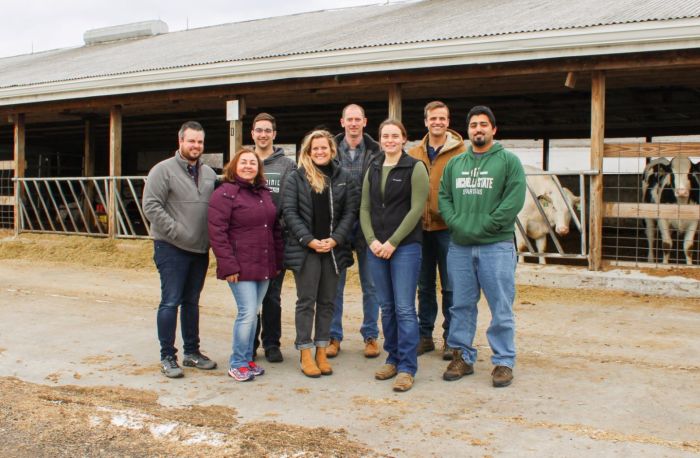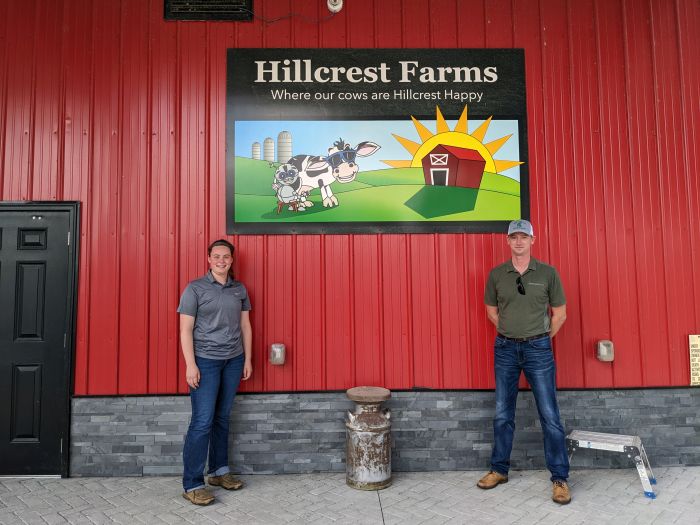cows,
Dairy cattle,
nutrient requirements,
feeding
Dairy cattle have nutrient requirements similar to that of a marathon runner but they have the extra challenge of needing to fill their «plate» halfway with salad! — Barry Bradford
For two years the Advisory Center of the Association of Milk Producers has been working closely with a team of dairy experts from Michigan State University. Every month Ukrainian advisors together with American colleagues and guest lecturers from other countries discuss the challenges of modern dairy production, deepen their knowledge and exchange experiences. In «Milk and Farm» magazine # 2(2025) we have published an interview with Barry Bradford, Clinton E. Meadows Endowed Chair in Dairy Management and Nutrition.

— Is there still anything which we do not know about dairy cattle feeding and nutrition? What fields are well studied and which require further research?
— Yes, the nutrition of ruminants is very difficult compared to studying monogastrics like pigs and poultry. Because there is so much that happens in the rumen, and it’s difficult to quantify those activities, we still have a lot to learn. Some of the key questions under investigation include:
- Is it more useful to think about 1 or 2 specific limiting amino acids or to consider a blend of essential amino acids to try to maximize milk production? Traditionally we have focused on identifying and supplementing the most limiting amino acid, but some studies over the last 10 years have suggested that the mammary gland might respond better to a blend of supplemental amino acids.
- Should we think about nutrient requirements differently at the start of lactation? There is a growing number of studies demonstrating improved health and productivity for many months when nutrition is improved during the first few weeks of lactation. Perhaps we need to generate a separate list of requirements for this unique phase of the production cycle. For example, several studies have pointed to benefits of feeding higher protein diets, supplying more B vitamins, and altering the source of dietary fatty acids in early lactation.

— Why did you choose dairy cattle nutrition, metabolism and dairy management as your professional focus?
— I grew up on a beef cattle farm, and I was always very interested in the science behind our management practices. During my time as a university student, I had my first opportunity to learn about dairy cattle and dairy farming, and I was amazed at the complexity of it. Dairy cattle have nutrient requirements similar to that of a marathon runner (scaled to their body size) but they have the extra challenge of needing to fill their «plate» halfway with salad! This makes dairy cattle nutrition a fun challenge, especially if you love ice cream and cheese. In the same way, running a dairy farm is so complicated compared to a beef operation, and I was attracted to the challenge of understanding a system like that. I am still learning every day, which is one reason I love my job.
— How do you distribute your time while teaching students at the University, working with farmers and doing research?
— Like everyone else, it seems like there is never enough time in my week. My job is officially focused 50% on research and 50% on Extension (supporting farmers, nutritionists, and veterinarians). Within my research role, I work with graduate students and research staff (Dairy Metabolism Group), which is where most of my teaching happens, although I do lecture for a few weeks each year. In my Extension work, I team up with university experts who live around our state, allowing them to be part of the communities we serve, and I also involve graduate students in these outreach projects. I am very thankful for technologies that make it possible to connect with people while driving or when I am speaking at a conference anywhere in the world. These tools help me stay organized and get more done, and because of that, my schedule is different every single day.
— Tell us more about Dairy Metabolism Group.
— The Dairy Metabolism Group integrates nutritional, environmental, and physiological variables to better understand the conditions that promote optimal health and productivity of dairy cattle. The dairy industry plays a critical role in the food system by upcycling nutrients that are not suitable for non-ruminants into fantastic things like ice cream and cheese. We take pride in carrying out research to improve the well-being of dairy cows and the sustainability of this critical industry.
Key areas of focus include:
- Inflammation and immunity in the transition to lactation. The time around calving is a period of great physiological change and high disease risk. We have helped to document an underlying inflammatory state during this period of time and we continue to explore the impacts of altering this state through pharmacological and nutritional tools.
- Nutrients as signals. One of the most significant developments in nutritional science (across species) is the recognition that nutrients and other feed components can have direct impacts on cellular function. Our team is contributing to the fundamental understanding of nutrients as signals and also exploring applications of «nutraceuticals» in the livestock sector.
- Evidence-based dairy management. Managing a modern dairy farm is incredibly complex, with seemingly infinite decisions to be made. Fortunately, sophisticated data collection systems on most farms provide a treasure trove of data available to be mined for insights into better decisions. We apply rigorous statistical approaches in combination with economic analyses to help managers make decisions that can improve the financial viability of their operations.

— How do you identify what issue needs to be studied?
— I am always looking for ideas, but most of them come from three sources. First, questions that are raised by dairy producers or their advisors are the most important, because they focus on immediate needs for making decisions. Secondly, new ideas emerge from conversations with other animal scientists; reading a new research almost always generates new questions. Thirdly, I try to stay on top of what is happening in biomedical research to think about how those concepts might (eventually) lead to new developments in livestock. There is almost 100 times as much money spent on biomedical research compared to animal agriculture research, so it would be foolish to not try to learn from that space.

— Knowing much about feeding dairy cattle and having achieved great results, what are the rules of thumb or major principles which top US dairy farmers follow in feeding their herds?
— The first rule of thumb is that high-quality forages are the key to high milk production. If a farm does not harvest and ensilage excellent corn silage, everything else is going to be a challenge. After that, supplying high quality protein with an appropriate quantity of rumen-bypass amino acids is important (diet formulation). Thirdly, feed management is essential — including proper mixing of ingredients, supplying diets across the entire feed bunk for at least 20 hours/day, and preventing feed spoilage.
— What are the indicators of efficient feed conversion and ideal/optimal ration?
— The most common tool for assessing feed conversion is to calculate feed efficiency as energy-corrected milk (adjusting to 3.5% fat and 3.2% protein) divided by dry matter intake. For an entire herd, our goal in the U.S. is typically to exceed 1.5 for this ratio. If we want to do better with feed efficiency, we can look into some narrower indicators as well. For example, milk urea nitrogen can provide insight into whether we are using protein in the diet efficiently. We can also collect manure samples from pens and lab analysis will provide pretty accurate estimates of nutrient digestibility; for example, we can assess whether we are achieving 95% starch digestion or not.
— What is the most demanding age or production group of animals on the dairy farm from the point of view of feeding and why?
— Clearly, the early lactation cow is the most demanding. These cows are not yet eating a lot, and some of them are frustratingly poor at consuming enough feed. At the same time, their milk production is rising rapidly, and they are often fighting some health problems. Because this stage of production is so unpredictable, many scientists in the past avoided studying this phase, so we are working to catch up on our understanding of nutrient needs during this time.
— How common on US dairy farms is the practice of giving calcium boluses to cows? What other ways to provide Ca are used?
— I don’t have access to real data to answer this question. However, my perception is that use of calcium boluses was greater 5 years ago, and it has been declining since then. One of the reasons for this is that there have been some high-quality studies published in the last several years showing that boluses have only marginal benefits for herds, and in some cases, they may have negative impacts. My perception is that many herds still give one or two calcium boluses to cows at the start of lactation 3 or greater (older cows) and to cows with twins, but otherwise, they have stopped using boluses. Instead, the focus has shifted to doing a better job with close-up cow management strategies (usually either a negative DCAD diet or zeolite supplementation). If we do a good job of helping the cow to prepare for lactation, she can pull calcium from her bones for a couple of days while she improves dietary calcium absorption, and calcium boluses are unnecessary and perhaps more stressful than beneficial.
— Do any US dairy farms have their own nutritionist? Who usually provides advise to the farmers on feeding programs, balancing rations, feed ingredients and additives? What is the most common or most successful mode of cooperation between the farmers and nutritionists?
— This is an interesting question. Today, probably 95% of U.S. dairy farms hire an external consultant to formulate ration and to provide general advice on feeds and even on farm management. Often, these experts provide excellent value, not only by providing expertise on complicated diet formulation work, but also by sharing ideas that they pick up from other farms as they travel in their roles. However, as our farms have increased in scale, there are real opportunities to keep someone with nutrition expertise busy at a single farm or a group of farms managed together. For less than is spent on an external consultant (in many cases), the on-site feed manager cannot only provide formulation services, but he/she can help to arrange cow grouping so that diets can be targeted to groups of cows with similar nutrient needs, coordinate feed inventories and track loss (shrink), train and evaluate the workers mixing and delivering feed each day, and coordinate feed harvest. Some farms are beginning to incorporate these roles, and I expect that trend to increase. In some cases, an external consultant may be used to bring new ideas to the farm, but they may only need to visit 2 — 4 times per year, and should be retained at a lower cost.
— For more than a year you have been cooperating with the advisors of the Association of Milk Producers of Ukraine. What can you share with them? Did you learn anything from them? What is the reason to share your expertise with Ukrainian dairy farmers?
— I always enjoy interacting with farmers from different countries; I find that it’s a great way to reconsider some things that I take for granted simply because of the environment that I work in. Different economic and political systems, soils, and weather patterns — all influence the practices that should be adopted by farms, and it’s easier to learn about these impacts by talking with people in different situations. However, my motivation to work with Ukrainian producers is certainly increased by my frustration at the injustice and suffering that our friends there are dealing with. There is little that I can do to improve the situation, but I want to do what I can. I have definitely learned things from our interactions over the past two years, and the biggest lesson that comes to mind right now is simply to be thankful for our own situation. Our producers here can often express frustration at how few good workers they can find, but at least they are not dealing with missiles landing in the barn or another power outage every week. The resilience of the Ukrainian people is an inspiration!

— What are the future challenges from the nutrition as well as sustainability perspective for the farmers and researchers?
— We will continually be asked to make more with fewer resources, either by a competitive market, government policies, or consumer demands. This means that we need to continue working for efficiencies, which bring both economic and environmental benefits. I also anticipate that the desire for «natural» production will continue to grow. This is one reason why some of my own research focuses on using plant phytochemicals to enhance the immune system responses of livestock. These ideas are very old, but there is still very little quality research on use of plant extracts to enhance health of cattle, and we are working to rigorously test these strategies. An important aspect of sustainability is economic sustainability, and farms will not last long if they are spending a lot of money on feeding products that don’t provide any real benefit.
| The Association of Milk Producers (AMP) extends its sincere gratitude to Barry Bradford, Clinton E. Meadows Endowed Chair in Dairy Management and Nutrition, and Phil Durst, Michigan State University Extension, for their expert support and contribution to the development of the Ukrainian dairy industry. Barry Bradford and Phil Durst, on a voluntary basis, have been organizing an online training course for the team of the AMP Advisory Center, involving leading experts from the United States and other countries. |